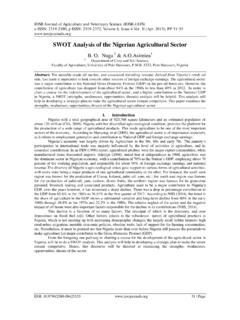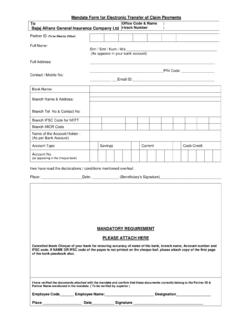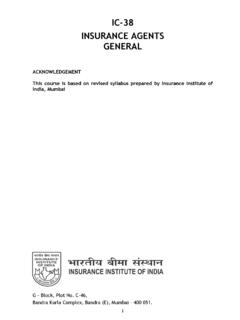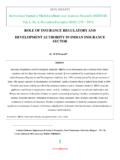Transcription of Customers’ Attitude towards General Insurance - A …
1 IOSR Journal of Business and Management (IOSRJBM). ISSN: 2278-487X Volume 3, Issue 1 (July-Aug. 2012), PP 30-36. Customers' Attitude towards General Insurance - A Factor Analysis Approach Ms. Tnr. Kavitha, Dr. A. Latha, Ms.. 1, 3 (Department of Management Science, Erode Sengunthar Engineering College, Erode, India.). 2. (Department of Commerce, LRG Government Arts College for Women, Tirupur, India.). Abstract: With over a billion people, India is fast becoming a global economic power. With a relatively youthful population, India will become an attractive Insurance market over the next decades. This paper examines the customer Attitude towards the General Insurance . A study has been conducted at Erode district with the sample of 750 respondents to find out the influencing factor of the policy holders in the study area. In this context, the respondents' opinion on the various related statements were collected with a 5 point scaling.
2 Factor analysis, an important multivariate technique has used to reduce the large number of factors in a small group of factors. 25 factors which are considered to be the different type of policy holders conscious. This study helps to find out the various customers which are having different expectation from the General Insurance Companies in the study area. Keywords: Buying Behavior, General Insurance , Global Economic Power, Influencing factor, Insurance Market. I. Introduction Insurance is defined as the simple mechanism of some people who are exposed to the same level of risks of suffering destruction of damage to their properties, that are likely to be caused by perils like accident, fire, floods earthquakes, etc., coming together and agreeing to share the loss sustained any one of the members';. that is, the loss of one or more members is spread among all.
3 Risk is uncertainty of a financial loss. It should not be confused with the chance of loss which is the probable number of losses out of a given number of exposures. It should not be confused with peril which is defined as the cause of loss or with hazard which is a condition that may increase the chance of loss. Finally, risk must not be confused with loss itself which is the unintentional decline in or disappearance of value arising from a contingency. Wherever there is uncertainty with respect to a probable loss there is risk. Every risk involves the loss of one kind or the other. The function of Insurance is to spread the loss over a large number of persons who have agreed to co-operate with each other at the time of loss. The risk cannot be averted but loss occurring due to a certain risk can be distributed amongst the agreed persons.
4 They have agreed to share the loss because the chances of loss, , the time and amount payables to a person are not known. Any of them may suffer loss due to a given risk, so, the rest of the persons who have agreed will share the loss. The larger the number of such persons, the easier the process of distribution of loss. In fact, the loss is shared by them by payment of premium which is calculated on the probability of loss. In olden times the contribution by the persons was made at the time of loss. However, now that this activity is organised, the Insurance companies collect the contributions in the form of premium even at the stage of agreeing to share the loss. The Insurance is also defined as a social device to accumulate funds to meet the uncertain losses arising through a certain risk to a person insured against the risk. II. Changing Scenario of General Insurance Industry The General Insurance Sector dominated by General Insurance Corporation (GIC) and its four subsidiaries since nationalization of Insurance , has started looking different now.
5 The major happenings in the last few years of privatization can be summarized as below: Functional autonomy of subsidiaries of GIC has been granted. GIC has been instructed to stop writing direct business and act as Indian reinsure. IRDA has finalized various guidelines and regulations. Competition was reintroduced in 2000 with the licensing of the first private company. Large number of new entrants in the private sector is already operational. The intense competition brought about by deregulation has encouraged the industry to innovate in all areas, from underwriting, marketing, policyholder servicing, and so on. Aggressive marketing strategies by private sector insurers have buoyed consumer awareness of risk and expanded the markets for products. 30 | Page Customers' Attitude towards General Insurance - A Factor Analysis Approach Competition in a deregulated environment has allowed market forces to set premiums that are appropriate for exposures and push insurers to differentiate their products and services.
6 Innovations in distribution and use of information technology have followed as public and private insurers compete to market their products. Allowing insurers to issue their own policy wordings April 1, 2008, and set their own rates Jan. 1, 2007 have enabled insurers to tailor products to meet client needs. So, the private sector was allowed into Insurance business in 2000. However, foreign ownership was restricted not to exceed 26 per cent of foreign investment. Table reveals that six companies from the public sector and 15 companies from the private sector have already entered into General Insurance business in India. The increasing demand and novelty of business opportunities in the Insurance market lured more and more players to enter into this field. TABLE 1. List of General Insurance Companies in India Name of the Company 1. The Oriental Insurance Company Limited 2.
7 The New India Assurance Company Limited 3. National Insurance Company Limited 4. United India Insurance Company Limited 5. Agriculture Insurance Company of India Limited 6. Export Credit Guarantee Corporation Limited 7. Royal Sundram Alliance Insurance Company Limited 8. Reliance General Insurance Company Limited 9. IFFCO Tokio General Insurance Company Limited 10. TATA AIG General Insurance Company Limited 11. Bajaj Allianz General Insurance Company Limited 12. ICICI Lombard General Insurance Company Limited 13. Appolo DKV Health Insurance Company Limited 14. Future General India Insurance Company Limited 15. Universal Sompo General Insurance Company Limited 16. Star Health and Allied Insurance Company Limited 17. Cholamandalam General Insurance Company Limited 18. HDFC-Chubb General Insurance Company Limited 19. Shri Ram General Insurance Company Limited 20.
8 Bharti Axa General Insurance Company Limited 21. Raheja QBE General Insurance Company Limited Source: III. Indian Scenario The Insurance sector in India has come a full circle from being an open competitive market to nationalization and back to a liberalized market again. Tracing the developments in the Indian Insurance sector reveals the 360 degree turn witnessed over a period of almost two centuries. Younger people are insuring themselves. The average age of an insured person is now 33, down from 37 five years ago. Indians are insuring more, the average sum assured is now three to five times the LIC's average of Rs. 83,000 per policy. Agents are being trained to understand the needs of a client and then suggest the best policy that meets the client's needs, rather than just sell anything. Additional benefits can be bought in the form of riders as cover against deadly disease, surgeries and disability due to accident.
9 The thrust is now on pension plans because life expectancy is going up and only 10% of population has pension cover. IV. Review Of Literature Gobi S. and Parthasarathy R (2011) in their paper suggested that India's tryst with health Insurance program goes back to the late 1940s and early 1950s when the civil servants (Central Government Health Scheme) and formal sector workers (Employees' State Insurance Scheme) were enrolled into a contributory but heavily subsidized health Insurance programs. As part of liberalization of the economy since the early 1990s, the government opened up the Insurance sector (including health Insurance ) to private sector participation in the year 1999. This development had thrown open the possibility for higher income groups to access quality care from private tertiary care facilities. As part of liberalization of the economy since the early 1990s, the government opened up the Insurance sector (including health Insurance ) to private sector participation in the year 1999.
10 This development had thrown open the possibility for higher income groups to access quality care 31 | Page Customers' Attitude towards General Insurance - A Factor Analysis Approach from private tertiary care facilities. India is a low-income country with 26% population living below the poverty line, and 35% illiterate population with skewed health risks. Insurance is limited to only a small proportion of people in the organized sector covering less than 10% of the total population. Currently, there no mechanism or infrastructure for collecting mandatory premium among the large scale informal sector. Sharma Aparajita (2011) in her study aims to develop the managerial competency framework for the middle level managers of the General Insurance sector in India. Secondary research provides the overview of existing generic competency models. The need was observed for a competency based framework in the Insurance sector in India.















